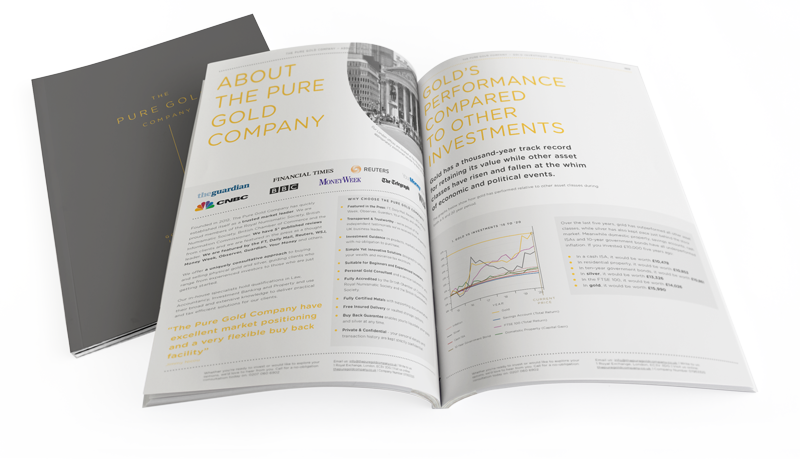For centuries gold has been used as a currency and a store of wealth in various physical forms, from coins to jewellery to decorative objects. These physical manifestations of the precious metal were the only way for retail investors to own the safe-haven asset until the 20th century, when stock market investing went mainstream and alternative asset classes were devised.
These days there are many ways to buy into gold without ever actually owning the physical metal. Exchange-traded funds, Contracts for Difference, digital gold, and mining stocks all require no interaction with actual gold but track the gold price as it moves.
Which gold is right for you? Physical bullion like coins or bars, or ‘Paper gold’? It’s essential to understand the pitfalls as well as the advantages when considering the type of gold that fits your portfolio.
Exchange Traded Funds
Gold-backed Exchange Traded Funds are funds in which you can trade shares like a stock. As the name implies, the shares are backed by underlying physical gold stores and track the gold price. In most cases, it’s unlikely that a holder of a gold-backed ETF would be in a position to cash in their shares for physical gold because the threshold for physical delivery is usually too high (over a million dollars for the most popular ETF). There is also some scepticism about whether the funds hold the total gold equivalent to back up the shares in their fund.
ETFs are popular because they are very liquid and easy to trade but they are not risk-free.
Even if you can’t liquidate your shares into gold, investors still have to rely on the fund to honour the investment. The fund is the first counterparty with the risk of default, but it’s not the last. The fund will inevitably use a financial institution to source and store the gold, and they add a second level of counterparty risk to the investment. It’s possible there will be further layers of counterparty risk in certain ETFs.
Although gold ETFs don’t attract spread charges, there are ongoing costs for holding the fund, and there may also be trading charges depending on which platform and ETF is used. ETFs also attract capital gains tax on the profit when sold. When considering a gold-linked investment, the risks and costs should be weighed alongside the liquidity benefits.
Contracts for Difference
Investors intent on avoiding owning the physical gold asset, even if by proxy in a fund, may choose to trade a Contract for Difference. This is an agreement between a buyer and seller to exchange the difference in the value of an asset over time. The buyer never has to own the asset (gold in this case), and can profit whether the price moves up or down, so long as they correctly predicted the direction of travel. This complex instrument is really only suitable for experienced investors as it comes with greater risk (of losses or counterparty risk) than trading ETFs or physical gold, but may appeal to those with a higher risk profile who want to trade on gold price movements in either direction. It’s important to note that while profits can be compounded, so can losses, which means you could lose more than your initial investment if the gold price moves in the opposite direction. Investors turn to physical gold because it holds intrinsic value, and this key principle is undermined by CFDs
Mining stocks
Gold miners are another way to gain exposure to gold on the stock market. Listed mining shares are easily traded and reflect, in part, the fortunes of the gold price. But the actual spot gold price forms only a part of the value of a gold miner.
Investing in gold mining stocks also means investing in the proficiency of management, the efficiency of operations, and the profitability of the company. In addition, investors take on counterparty risk, country risk depending on where their mines are located, safety risk, debt risk and other organisational risks that affect the share price irrespective of how the gold price performs.
Mining shares are suitable for investors who want exposure to stocks that are linked to the price of gold but also reflect the corporate fortunes of the company. The highs are high but the lows can be very low, which ultimately undermines the objective of investing in gold, namely safety and security.
Digital Gold
Digital Gold is an electronic form of currency that is based on units of physical gold. The owner of the digital gold has a claim on its physical counterpart but often never chooses to ‘collect’ on the gold. Instead, the digital gold can be held, sold, or used to make purchases.
Ultimately, digital gold must be issued and underwritten by a company or institution, which carries substantial counterparty risk. Some digital gold is recorded in the same blockchain format as cryptocurrencies and is held as tokens in a digital wallet and sold on exchanges. This association with cryptocurrencies may be detrimental to its reputation, but the argument is that digital gold is backed by the physical product, unlike other cryptocurrencies.
Other institutions are selling digital gold within their platforms as a way for investors to own gold without the restrictions of coin or bar weight. The gold is never delivered but is allocated to the investor as a fractional part of a larger 400-gram bar, and can be bought or sold back to the provider digitally. This digital gold relies entirely on the counterparty to uphold its obligations, and it still incurs storage fees.
Discover Gold’s Unique Tax Advantage
Most investments are subject to some form of taxation, but physical gold can be totally free of VAT and capital gains tax.

Physical gold
While paper gold will always have a place in the investment pantheon, physical gold has inherent advantages that may be overlooked. This could be because investors aren’t aware of the ease with which physical gold can be bought or sold today or because some advisors may not be in a position to advise on physical gold, so default to paper gold guidance instead. In addition, paper gold is often portrayed as cheaper and easier to own, but there are usually ongoing management and trading fees for holding paper gold in the same way as physical gold incurs storage costs (unless it is delivered).
Depending on individual circumstances, physical gold is VAT free, and in currency coin format also incurs no capital gains tax. Taking delivery or utilising storage within a secure vault removes the counterparty risk associated with paper gold, removing it from the financial system altogether in a way that paper gold can never be.
This is one of the most important advantages of physical gold, because in the event of financial upheaval, the yellow metal still belongs to the investor. Owning the physical metal is the best way to utilise gold’s safe-haven status and ensure investors benefit from its security and long-term store of value.
Advantages of different types of Gold Investment
(Mobile users are recommended to view this table in landscape position)
| Type of Gold | ADVANTAGES | DISADVANTAGES |
|---|---|---|
| Physical Gold Coins | Completely tax-free depending on individual circumstances (if investing in Royal Mint minted coins) No counterparty risk, tangible asset Intrinsic value Currency value Private investment VAT exempt on investment grade gold No management charges Very liquid and divisible High buy-back prices | Can’t put into a SIPP or Pension Less demand for non-UK Residents |
| Physical Gold Bars | No Counterparty risk, tangible asset, has intrinsic value, private investment VAT exempt on investment grade gold No management charges Can purchase gold bullion bars within SIPP/Pension | Capital Gains Tax is applicable to any growth Potentially reportable – less private than coins Less demand results in weaker buyback prices compared to coins |
| EFT | Relatively cheap, fast & easy to buy and sell Can purchase gold bullion bars within SIPP/Pension | Counterparty risk, may not be fully physically backed Cannot take physical delivery Gains and losses can be larger than changes in gold price Annual management charges Taxes applicable No income |
| Gold Fund | Well-established, easy to access Relatively cheap Can purchase gold fund within SIPP/Pension | Counterparty risk, may not be fully physically backed Cannot take physical delivery Gains and losses can be larger than changes in gold price Annual management charges Taxes applicable No income |
| Gold Mining Company | Potential for higher gain than the gold price Dividend potential | Counterparty risk, potentially high risk, apart from gold performance Share price is determined by how company is run and the profitability of gold mine |
| Spread betting | Potential for very high gains Tax-exempt | Speculative, complicated and high risk Can lose more than your initial investment |
| Futures | Potential for very high gains | Speculative, complicated and high risk Can lose more than your initial investment |
| C F D | Potential for very high gains | Speculative, complicated and high risk Can lose more than your initial investment |


